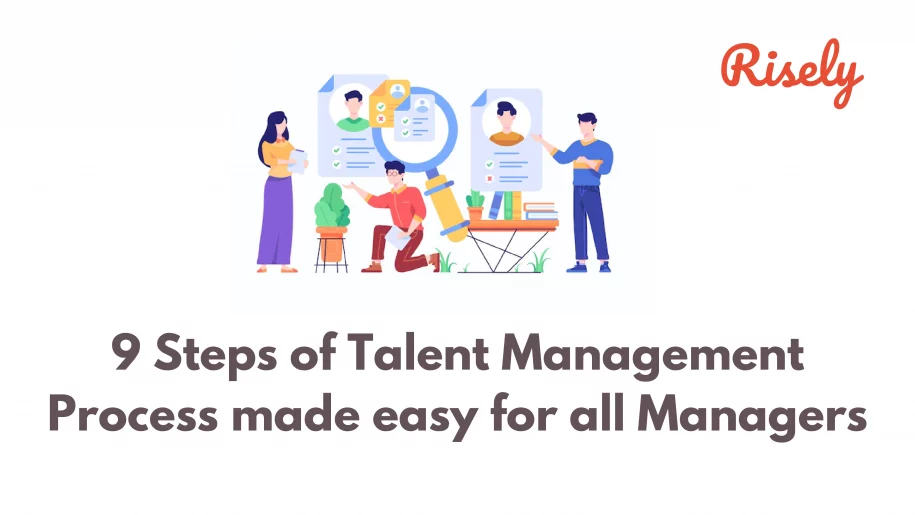9 Steps of Talent Management Process made easy for all Managers
Talent management is an essential aspect of any organization’s success. It involves identifying, attracting, developing, and retaining talent to achieve business goals. Studies have shown that companies with effective talent management strategies outperform their competitors in revenue growth and profitability. In this blog post, we will discuss the importance of talent management, its process and life cycle of, and how you can become better at managing talent. We will explore strategies and best practices to help you build a robust talent management program to attract, develop and retain the right people for your organization’s success. So, let’s dive into the world of managing talent!What is Talent Management?
Talent management is the comprehensive process of attracting, developing, and retaining skilled individuals. It encompasses a range of strategies and practices aimed at identifying, nurturing, and leveraging talent to achieve organizational objectives. It involves HR activities such as recruitment, selection, onboarding, training and development, performance management, succession planning, and employee engagement. These processes collectively ensure that the right people are in the right roles and equipped with the necessary skills and support to contribute effectively to the organization’s success.Importance of Talent Management
Talent Management plays a pivotal role in the success and sustainability of organizations. In a rapidly evolving business landscape, where talent is a valuable asset, effective strategies for managing talent become essential to attract, develop, and retain top performers. It allows organizations to attract and hire skilled individuals with the necessary expertise and capabilities to drive business growth. By implementing robust recruitment and selection processes, organizations can identify talent that aligns with their values and objectives. This ensures a pool of qualified candidates who can contribute to the organization’s success. Additionally, talent management helps create a positive employer brand, attracting high-potential candidates and differentiating the organization from its competitors. Also, talent management focuses on the development and a culture of continuous learning for employees. By investing in training programs, mentorship, and career development opportunities, organizations enhance the skills and knowledge of their workforce. This improves employee performance and cultivates a culture of innovation and adaptability. Furthermore, it involves succession planning, which identifies and prepares future leaders within the organization. This proactive approach ensures a seamless transition of leadership, minimizes talent gaps and sustains organizational effectiveness in the long term.Other Interesting Reads
Talent Management Process & Life Cycle
The talent management process refers to the systematic approach used by organizations to attract, develop, motivate, and retain talented individuals. It involves interconnected steps designed to optimize the organization’s talent pool. At the same time, the talent management life cycle refers to the various stages involved in managing talent within an organization, from attracting candidates to their development and eventual departure. However, the steps of the talent management process and life cycle can, be depicted as follows. While their specific stages may vary across organizations, here is a general outline of the same.- Planning and Strategy: The talent management process begins with aligning strategies with the organization’s goals and objectives. This involves identifying the skills, competencies, and positions needed to achieve those objectives and creating a plan for managing talent.
- Attraction and Recruitment: In this stage, organizations focus on attracting qualified candidates through various channels such as job postings, career fairs, online platforms, and networking. Recruitment efforts aim to reach potential talent and generate a pool of candidates who meet the organization’s requirements.
- Selection and Hiring: The selection phase involves assessing candidates through interviews, assessments, reference checks, and other evaluation methods to identify the most suitable individuals for the positions. The hiring decision is based on the evaluation results and alignment with organizational needs.
- Onboarding and Integration: Once candidates are hired, the onboarding process begins. This includes providing necessary information, orientation, and training to help new employees become familiar with the organization’s culture, policies, procedures, and roles. Effective onboarding facilitates a smooth integration into the organization and sets the foundation for employee success.
- Development and Training: This stage focuses on employees’ ongoing learning and development opportunities. Organizations provide training programs, workshops, mentoring, coaching, and other developmental initiatives to enhance employees’ skills, knowledge, and capabilities. Development plans are tailored to individual needs, career aspirations, and organizational requirements.
- Performance Management: Performance management involves setting clear goals, providing regular feedback, and evaluating employee performance. Managers and employees engage in performance discussions to review achievements, identify areas for improvement, and align performance with organizational objectives. This stage helps identify high-potential employees and provides opportunities for recognition and rewards.
- Succession Planning: Succession planning aims to identify and develop future leaders within the organization. It involves assessing employees’ potential and readiness for leadership roles and creating plans to groom them for critical positions. Succession planning ensures a smooth transition of leadership and minimizes talent gaps.
- Employee Engagement and Retention: Engaging and retaining talent is crucial to the talent management life cycle. Organizations implement strategies to enhance employee engagement, such as providing a positive work environment, offering competitive compensation and benefits, recognizing achievements, and promoting work-life balance. These efforts contribute to employee satisfaction, loyalty, and long-term retention.
- Separation and Transition: At some point, employees may leave the organization due to retirement, career changes, or other reasons. The talent management process also involves managing employee separations and transitions respectfully and professionally. This can include exit interviews, knowledge transfer, and maintaining positive relationships with former employees.
How to become better at talent management?
Talent Management is a crucial aspect of organizational success, encompassing strategies, and practices to attract, develop, and retain top talent. Organizations must adopt effective approaches to secure a skilled and engaged workforce in today’s competitive landscape. This section explores key strategies and best practices organizations can implement to optimize talent acquisition, development, and retention efforts. Organizations can cultivate a high-performing workforce and gain a competitive edge in the market by aligning talent management practices with business objectives and fostering a supportive work environment.Talent Management Strategies
Organizations often employ the following five strategies to attract, develop, and retain top talent. Remember, these strategies are not exhaustive, and organizations should tailor their approaches to suit their specific needs and objectives.- Recruitment and Selection: This strategy focuses on attracting highly skilled individuals who align with the organization’s values and goals. It involves using various recruitment channels, such as online job portals, social media platforms, and professional networks, to identify and engage potential candidates. Effective selection processes, including interviews, assessments, and reference checks, help ensure the right fit for the organization.
- Employee Development and Training: This strategy emphasizes employees’ continuous learning and development. Organizations invest in training programs, workshops, seminars, and online courses to enhance employees’ skills, knowledge, and capabilities. Development opportunities can include leadership development, technical skills training, mentoring programs, and cross-functional assignments, fostering employee growth and career progression.
- Performance Management: Performance management involves setting clear goals, providing regular feedback, and evaluating employee performance. Organizations establish performance metrics and conduct periodic reviews to assess individual and team achievements. Effective performance management systems enable the identification of high-potential employees, provide opportunities for recognition and rewards, and address performance gaps through coaching and support.
- Succession Planning: Succession planning focuses on identifying and developing future leaders within the organization. It involves assessing employees’ potential and readiness for leadership roles and developing plans to groom them for future positions. Succession planning ensures a pipeline of talented individuals who can step into key roles when needed, reducing talent gaps and enhancing organizational stability.
- Employee Engagement and Retention: This strategy aims to create a positive work environment and foster a sense of commitment and loyalty among employees. Organizations employ various initiatives, such as competitive compensation packages, work-life balance programs, recognition and rewards systems, and employee wellness programs, to enhance job satisfaction and engagement. Regular communication, opportunities for career advancement, and a supportive culture also contribute to retaining top talent.
Talent Management best practices
- Strategic Alignment: Align talent management practices with organizational goals and objectives to drive success.
- Clear Job Descriptions: Provide clear and comprehensive job descriptions to attract suitable candidates and set performance expectations.
- Effective Onboarding: Implement a well-structured onboarding process to help new hires integrate quickly and contribute to the organization.
- Continuous Learning: Encourage ongoing learning and development opportunities to enhance employee skills and keep up with industry trends.
- Performance Feedback: Provide regular and constructive feedback to employees to improve performance and drive improvement.
- Career Pathing: Develop clear career paths and growth opportunities to engage and retain talented individuals within the organization.
- Succession Planning: Identify and groom high-potential employees for future leadership positions to ensure continuity and minimize talent gaps.
- Diversity and Inclusion: Foster a diverse, inclusive work environment that values different perspectives and experiences.
- Employee Engagement: Implement initiatives to enhance employee engagement, such as recognition programs, work-life balance, and open communication.
- Data-Driven Decision Making: Leverage talent analytics and data to inform talent management decisions and drive strategic outcomes.
Conclusion
Talent management attracts, develops, and retains talented employees to achieve your business objectives. It’s no secret that top talent is essential to the success of any organization. Talent management is crucial in ensuring you have the right people in the right positions at the right time. To optimize your process of managing talent, you must develop effective strategies and implement best practices aligning with your organizational goals. Implement the strategy given in our blog on talent management best practices and strategies to learn how to become better at attracting, developing, and retaining top talent in today’s hyper-competitive business environment.Sharpen your strategic thinking skills with a free assessment to ensure effective talent management.
Start the free strategic thinking assessment for managers to lead your team like a pro!
Frequently Asked Questions
What are the four components of talent management?
The 4 components of talent management are Career Pathing, Succession Planning, Diversity and Inclusion, and Employee Engagement. Leverage data-driven decision-making to inform decisions and drive strategic outcomes.
What is the role of talent management?
The role of talent management is to ensure that an organization has the right people in the right positions at the right time. This involves attracting, developing, and retaining talented employees to achieve your business objectives. It is also crucial in minimizing talent gaps and fostering a diverse and inclusive work environment that values different perspectives and experiences. Organizations can make informed decisions that drive strategic outcomes by leveraging data-driven decision-making.
What is the talent management cycle?
The talent management cycle refers to continuously attracting, developing, and retaining talented employees. This includes identifying workforce needs, recruiting top talent, providing learning and development opportunities, assessing performance, and creating career advancement paths. By implementing effective practices throughout this cycle, organizations can always ensure they have the right people in the right roles. It’s a crucial process for achieving long-term success and driving strategic outcomes.
Other Related Blogs
How to Create a Course with AI: A Guide for L&D Professionals
How to Create a Course with AI: A Guide for L&D Professionals According to a McKinsey survey(1), only 11% of business leaders believe their leadership development initiatives yield meaningful results.…
How to build a Learning and Development Action Plan ft Katie Greenwood
How to build a Learning and Development Action Plan ft Katie Greenwood Does your company’s Learning and Development (L&D) strategy feel like more “guessing” than “winning”? You’re not the only…
Generative AI for Learning and Development: Getting Started
Generative AI for Learning and Development: Getting Started In 2024, organizations spent $401 billion globally on corporate training(1), yet 70% of employees report feeling unprepared for the future of work…
Future proofing a learning strategy for organizations with Inna Horvath
Future Proofing a Learning Strategy for Organizations with Inna Horvath With the advent of AI, everyone’s anticipating changes. L&D leaders in charge of building a learning strategy for organizations are…


